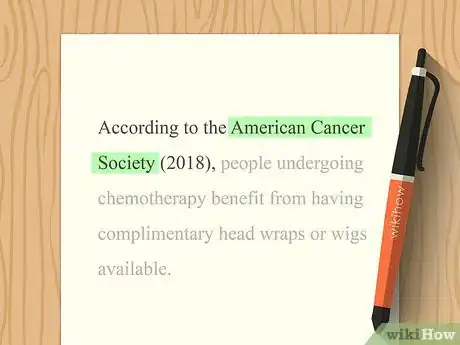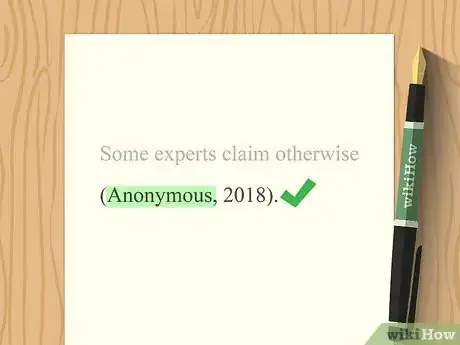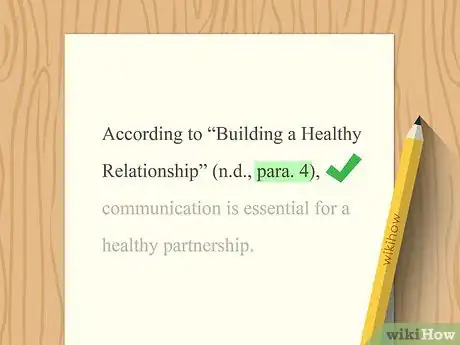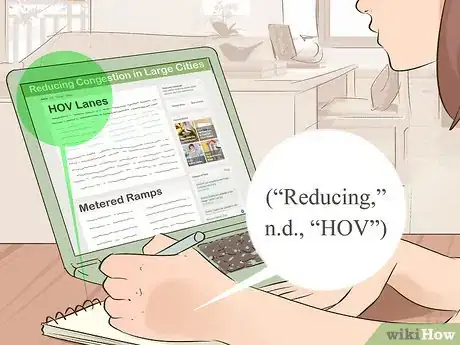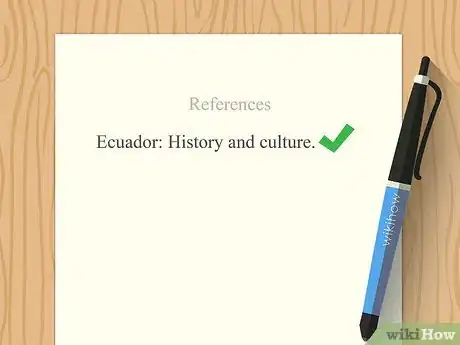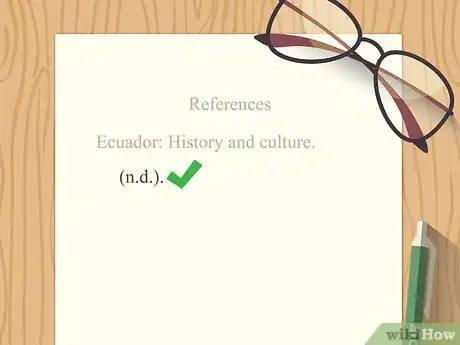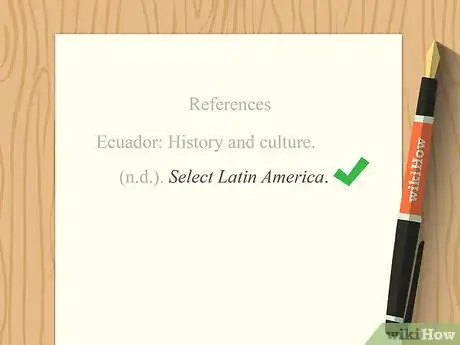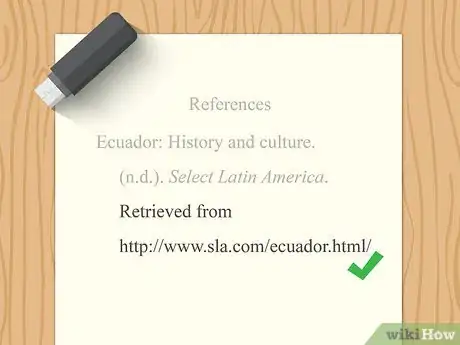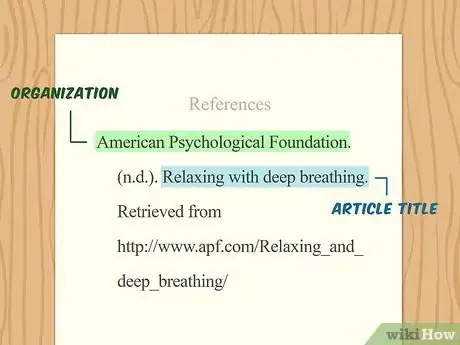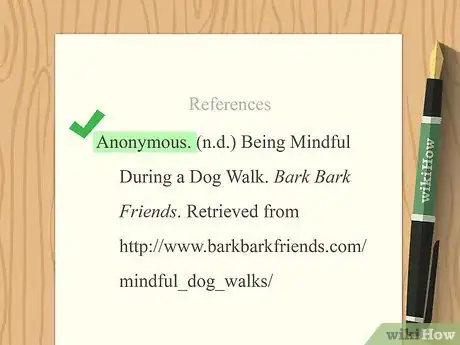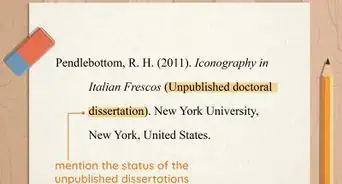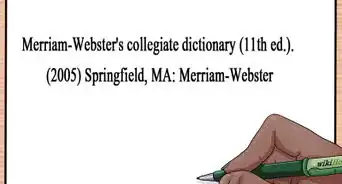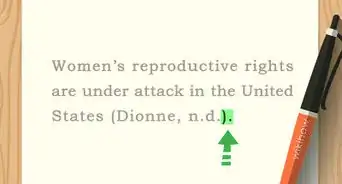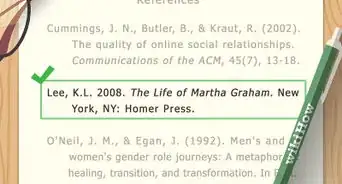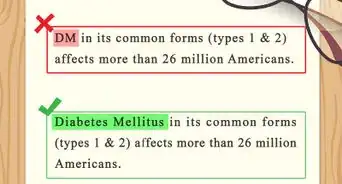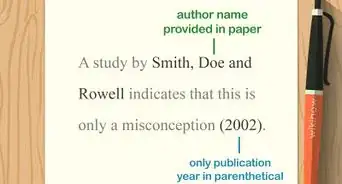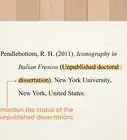This article was co-authored by Diane Stubbs and by wikiHow staff writer, Danielle Blinka, MA, MPA. Diane Stubbs is a Secondary English Teacher with over 22 years of experience teaching all high school grade levels and AP courses. She specializes in secondary education, classroom management, and educational technology. Diane earned a Bachelor of Arts in English from the University of Delaware and a Master of Education from Wesley College.
There are 11 references cited in this article, which can be found at the bottom of the page.
This article has been viewed 255,456 times.
Citing a website that doesn't list an author, date, or page number can be tricky. However, it's easier to do than you might think! You can cite a website using the title name, organization that published the page, or "anonymous," depending on the information available. For the date, you can include "n.d." for "no date." This allows you to create in-text citations and an entry on your References page.
Steps
Creating In-Text Citations
-
1Use the title in place of the author if there's no author at all. Write out the full title of the work if you're citing it within the sentence. If you are using a parenthetical citation only, use the first 1-2 words of the title.[1]
- Here are examples of alternatives for citing a page entitled “Robotics for Beginners”:
- "According to “Robotics for Beginners" (2018), titanium parts will create a sturdier robot."
- "Titanium parts are the best option for building a sturdy robot (“Robotics,” 2018)."
- Here are examples of alternatives for citing a page entitled “Robotics for Beginners”:
-
2Treat an organization as the author if they published the website. You can find reliable information from groups and organizations, but they don't always list an author. If this is the case, you can cite the organization as the author since they published the information.[2]
- For example, you might pull information from the American Cancer Society's website. If no author is listed, you can use the organization instead. Your in-text citations could look like this:
- "According to the American Cancer Society (2018), people undergoing chemotherapy benefit from having complimentary head wraps or wigs available."
- "People who are undergoing chemotherapy treatments have a better experience if complimentary head wraps and wigs are provided to them (American Cancer Society, 2018)."
Advertisement - For example, you might pull information from the American Cancer Society's website. If no author is listed, you can use the organization instead. Your in-text citations could look like this:
-
3Include “Anonymous” as an author if it's on the website. You might come across a website page that lists an anonymous author. If this is the case, you can use “Anonymous” as the author in your citation.[3]
- For an anonymous author, your citation will look like this: "(Anonymous, 2018)"
-
4Use "n.d." for no date in your citations. APA citations usually include the author and date. However, you can't include a date if one isn't there! Using "n.d." tells the reader that no date is provided on the site.[4]
- A citation using a title for an author looks like this: "(“Robotics,” n.d.)"
- If you're using an organization name, your citation looks like this: "(National Robotics Society, n.d.)"
- For an anonymous author, your citation would look like this: "(Anonymous, n.d.)"
-
5Include the paragraph to cite a specific passage if there's no page. APA formatting only requires a page number when you need to cite specific words or a close paraphrase or summary of a particular section. When a website doesn't have page numbers, you can use the paragraph number instead. Count the paragraphs to figure out which paragraph you are citing. Then, write "para." for "paragraph" and the number of the paragraph.[5]
- For example, let's say you're citing the 4th paragraph of an article called, “Building a Healthy Relationship,” which has no author, page number, or date.
- You could cite it like this:
- "According to “Building a Healthy Relationship" (n.d., para. 4), communication is essential for a healthy partnership."
- "Partners must communicate if they want to have a healthy relationship (“Building,” n.d., para. 4)."
-
6Use 1-2 words of the section heading as the page number if available. Section headings or subheadings are a great way to tell readers where to find the information you're citing. You can use these headings instead of the paragraph number if there are no page numbers. If the page you're on has marked headings, use those in place of a page number to cite a specific area where you found the information you're citing.[6]
- You may have found valuable information on a web page titled “Reducing Congestion in Large Cities,” which has section headings titled “Improving Transit Networks,” “Increasing Highway Capacity,” “Collecting Tolls,” “HOV Lanes,” and “Metered Ramps.” However, there's no date or page number.
- Your citation might look like this: "(“Reducing,” n.d., “HOV”)"
Preparing Your References Page
-
1List the title of the article first if no author is listed. Only capitalize the first word, words that come after a colon, and proper nouns. Don't put quotation marks around the title. Put a period after the title.[7]
- Let's say the name of the article you want to cite is “Ecuador: History and Culture.” The beginning of your entry would look like this: "Ecuador: History and culture."
- If the article includes an organization name or an anonymous author, you'll use that instead of the title.
-
2Write n.d. for "no date" in parentheses after the title. This tells the reader that no date was included. Use lowercase letters and include a period after the “n” and “d.” After the parentheses, put a period.[8]
- Your entry would now look like this: "Ecuador: History and culture. (n.d.)."
-
3Include the name of the organization, publication, or website in italics. Capitalize each word of the name, except for “of,” “and,” and “to.” Put a period after the name.[9]
- This is what your entry should look like now: "Ecuador: History and culture. (n.d.). Select Latin America."
-
4Write “Retrieved from,” then include the website's URL. Include the entire URL of the site where you found the information you're citing. Do not put any punctuation at the end of the citation, unless it appears in the URL.[10]
- Here's how your final entry might look: "Ecuador: History and culture. (n.d.). Select Latin America. Retrieved from http://www.sla.com/ecuador.html/"
-
5List the organization first in the reference if one is listed. Just as in your in-text citations, you can use the organization that published the article if one was provided. Write the organization name first in your entry on your References page, in the same place you'd put the author.[11]
- If the website name is the same as the organization name, don't write it again after the page title. You can skip that part of the references entry and go straight to "Retrieved from."
- For example, let's say you're citing an article called “Relaxing with Deep Breathing,” which was published by the American Psychological Foundation. No date is provided.
- Here's what your entry would look like: "American Psychological Foundation. (n.d.). Relaxing with deep breathing. Retrieved from http://www.apf.com/Relaxing_and_deep_breathing/"
-
6Put anonymous first in your entry if it's given as the author. Write “Anonymous” in place of the author in your citation, then format the rest of your entry as a typical website reference.[12]
- You might be citing a web page titled “Being Mindful During a Dog Walk,” written by an anonymous author. It's posted on a website called Bark Bark Friends, but there isn't a date.
- Here how your entry would look: "Anonymous. (n.d.) Being Mindful During a Dog Walk. Bark Bark Friends. Retrieved from http://www.barkbarkfriends.com/mindful_dog_walks/"
Warnings
- Citing your sources can be frustrating, but don't give up! If you don't cite your source, you'll be plagiarizing the site where you got the information. This can cost you credit for the assignment and can result in other academic consequences.⧼thumbs_response⧽
References
- ↑ https://owl.purdue.edu/owl/research_and_citation/apa_style/apa_formatting_and_style_guide/in_text_citations_author_authors.html
- ↑ https://owl.purdue.edu/owl/research_and_citation/apa_style/apa_formatting_and_style_guide/in_text_citations_author_authors.html
- ↑ https://aus.libguides.com/apa/apa-no-author-date
- ↑ https://apastyle.apa.org/style-grammar-guidelines/references/missing-information
- ↑ https://guides.libraries.psu.edu/apaquickguide/intext
- ↑ https://bowvalleycollege.libguides.com/c.php?g=714519&p=5093747
- ↑ https://columbiacollege-ca.libguides.com/apa/booksandebooks
- ↑ https://libguides.jcu.edu.au/apa/dates
- ↑ https://owl.purdue.edu/owl/research_and_citation/apa_style/apa_formatting_and_style_guide/reference_list_basic_rules.html
- ↑ https://owl.purdue.edu/owl/research_and_citation/apa_style/apa_formatting_and_style_guide/reference_list_electronic_sources.html
- ↑ https://writingcenter.uagc.edu/format-your-reference-list
- ↑ https://libguides.ggc.edu/apastyle_7th/Authors/MissingorAnonymous
- ↑ https://aus.libguides.com/apa/apa-no-author-date
About This Article
Citing information from a website without an author, date, or page number isn’t as complicated as you might think. Try using the title in place of an author for an in-text citation. For example, for a page entitled “Robotics for Beginners,” you could write (“Robotics,” 2018). Alternatively, list the name of the organization that owns the website in your in-text citation, like “According to the American Cancer Society (2018).” If you don’t have a date, add “n.d.” instead. Replace page numbers by mentioning the paragraph your citation comes from. For instance, if it came from the fourth paragraph, add “para 4” to the end of an in-text citation. If you put all of this together, an in-text reference could look like, “According to Robotics for Beginners (n.d., para 4). For tips on how to write a citation for your reference page that doesn’t have an author, date, or page number, read on!

